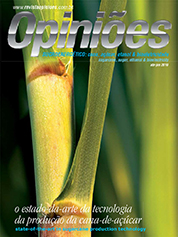Humberto César Carrara Neto
Agricultural Manager of Usina São João
Op-AA-24
Soil preparation for harvesting
If we were to list the vectors for introducing new technologies in the sugarcane production chain, the mechanization of harvesting would no doubt be one of the main access portals and inducers of such new technologies. Undisputedly the mechanization of harveting, has in the past two decades been the directional guide or fosterer of all types of technologies, from breeding of new varieties to the selection of greenfield locations, or even to perpetuating companies al-ready in operation in the industry.
If we restrict ourselves solely to observing the sugarcane production chain, all processes are also subordinated or conditioned to allow and optimize the mechanical harvesting process. Soil preparation would be no different, given that it is one of the most important conditioners of mechanical harvesting, and as such, serves the purpose of acting as a recipient of progress in production technology.
One may state that the soil preparation process does not change an area’s terrain profile, but it may well prepare it for planting, allowing the crop to be planted under optimal conditions considering mechanical harvesting and its achieving performance levels at low operational cost, without adversely affecting productivity, i.e., the business´ very sustainability.
One of the main concerns of an industry that produces energy must precisely be its energy balance, or in other words, how much energy its production chain consumes to produce it. Thus, a process that consumes approximately 96 liters of fossil fuel per tilled hectare should be the object of study and assessment by the responsible specialists, to review the adopted practices, the sequence and the intensiveness of operations, the selection of machinery and the respective horsepower employed, along with the matching machine accessories.
A concept recently introduced in the industry, clearly derived from mechanical harvesting, is that of a “construction site”. As is well known, harvesting causes great impact on soil compression and therefore tech-niques and equipment have recently started being used to “localize” or “apply” such unavoidable compression in areas distant from the radicular system, where they may cause less damage to the crop’s development.
Technologies still under development or in the process of being introduced, such as Precision Agriculture, Geo-referencing, Automatic Piloting, Telemetry, and Remote Controlled Equipment, are already making feasible and allowing the expansion of “construction sites”, which, in turn, will probably result in that Soil Preparation will enter a new development stage, that of Guided Preparation or Minimal Planting.
We would then be absorbing technology that would allow us to adapt the plantation for mechanical harvesting, while preserving the soil and considerably improving our energy performance to the extent that we may reduce fossil fuel consumption in obtaining a renewable fuel. The expansion and the imminent systemic adoption of crude cane harvesting, without resorting to burning to eliminate leaves, will, let me repeat this, confront us with harvesting as an inducer of new technologies, and will require the adaptation and development of new Soil Preparation practices.
The volume of straw accumulated in successive harvests of crude sugarcane will require that new equipment and practices be incorporated and operated. Again, the industry, society and an entire production chain stands to benefit from the moment when soil preparation practices become less damaging to the crop’s sustainability environment, to soil, while also allowing for the incorporation of organic material to the medium and lesser consumption of fossil energy in the process.
This is what one may refer to as Sustainability. When the subject is New Technologies, we may and should dream, because dreams foster discoveries, or re-discoveries, as in this case. For a long time the members of GMEC, a group of technicians in the area of mechanization in the sugar-based energy industry, has recommended and encouraged manufacturers of machines and engines to develop dual-fuel (flex-fuel) technologies for high-power diesel/ethanol engines.
This is close to becoming a useful technology in the market, economically applicable, with precisely the machines used in harvesting and soil preparation becoming the technology recipients. At this point the dream will become reality: we will economically consume the same fuel we produce, but we will reach sustainability levels close to the maximum possible in the production chain.




